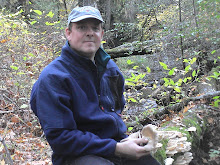January rains can dampen the spirits unless you look for the silver, or in this case, the golden, lining – beautiful egg yolk colored chanterelles. I first picked chanterelles in Europe. Over there they are delicate little things not much bigger than your thumb. Here they are some kind of a mutant fungal Godzilla, growing exuberantly in huge patches and sometimes as big as your fist. This is good news because when they are out they are in abundance. These beauties are from just up the hill at my friend Barry’s place. He had a chef friend staying last weekend and as they strolled along his lane, they spotted a giant chanterelle patch. Barry quickly alerted Sally and me, as he knows we are the Foothill fungal foragers. We set off for the woods to beat the big storms and gathered enough to feed the neighborhood.
If you are lucky enough to find your own patch, or even to buy some from a decent market, here is how to prepare them. If you prefer to watch rather than read, here is a video.
Your preparation should begin in the woods. Pluck or cut your chanterelles from the duff and shake off as much dirt as possible. If you have a mushroom knife with a brush, use it to remove as much mud and leaves as you can. Then place your chanterelles stem down into your basket. Debris will then fall to the bottom of the basket or on to the smooth tops of the mushrooms rather than into the forked gills where it will be trapped and difficult to remove later. If you hit a mother lode then stack them the same way into paper carrier bags. When you get home, you can rip the bag open to get at them and they will look like this.
Clean the chanterelles using a mushroom brush like the one in the picture. You can use a pot or nail brush but the bristles tend to be just a little too hard so they tear the mushrooms. A paintbrush is another alternative but a little too soft which means it skips over the dirt rather than pulling it out. The best readily available alternative is a soft toothbrush. However, if you like mushrooms, buy a brush at your favorite kitchen store and you will be set. Use the brush in downward strokes toward the stem. The gills of a chanterelle are forked and if you go the other way, you will end up compacting the dirt into them where it is a bugger to get out.
With most of the dirt brushed off use the rounded side of your mushroom knife blade, or simply a paring knife, to scrape down the stem and slice off the end. A few minutes work and you will have a pile like this. Still with a few specks of dirt adhering, but hey, it’s a natural product and maybe a little exposure will boost your immune system. The dirt is not a taste problem if your haul was plucked from a fine clay soil where chanterelles usually grow, as it will not produce a tooth grinding grit as you might get with spring morels.
Heat a large sauté pan on medium heat until warmed through and then throw in the chopped chanterelles.
As the mushrooms warm up they will start to give up their excess moisture into the pan. At first, it is a trickle but it quickly becomes a flood and your mushrooms will be swimming. This is why you are dry sautéing. If you had popped the mushrooms straight into oil or butter, you would have a soggy emulsified mess. Continue to sauté or stir the mushrooms, adjusting the heat so that the water gently boils off and you start to get a little light color on the surface. All the water is boiling off but the flavor is concentrating back in the pan. What looked like a crowded pan is now shrinking down to meaty little nuggets of chanterelle goodness.
When the pan is dry and the surface of the chanterelles a golden brown, you can finish them off by adding a little decent olive oil and a dollop of good butter. I like to use Plusgras, which you can find in better markets in a red wrapper. Plus Gras is French for more fat, I think that the manufacturers realized that translating that for the US market might not be the biggest boost to sales. However, more fat is just what you need for great flavor. Please do not ever finish your mushrooms with any kind of ersatz low fat butter flavored margarine or other substitute. The culinary gods are watching and they will smite you for that blasphemy!
The higher temperature of the oil and butter will allow you to get more caramelization on the mushrooms. Remember, no color, no flavor. However, do not overdo it; you do not want them burnt. The final touch is to season with salt and pepper to yield beautiful tender mushroom pieces. They will have a subtle woodsy aroma, a delicate complex flavor and a slightly crunchy bite. You can decadently munch then as they are or serve as a rich accompaniment to your favorite grilled protein. Alternatively, deglaze the pan with a little sherry and finish with some cream and fresh garden herbs for a rich sauce to pair with game.
Bon Appetit!
Nick










